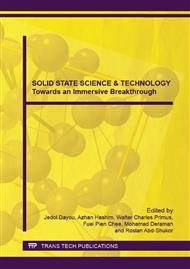p.454
p.460
p.466
p.471
p.477
p.485
p.491
p.496
p.502
Aqueous Corrosion Investigation of Yb Doped Lead Oxychloride Tellurite Glass
Abstract:
Series of glass based on (80-x)TeO2-10PbO-10PbCl2-xYb2O3 where 0.0 ≤ x ≤ 3.0 were successfully prepared via melt quenching technique. The corrosion rate measurement was carried out by immersing the glass in various pH solutions in the range of pH 2 to 11. The alteration in surface morphology and structural characteristics was examined using field emission scanning electron microscopic and X-ray diffraction measurements. The corrosion investigations showed that the corrosion rate of the glass decreased over time due to the formation of protective layer on the glass surface. Furthermore, the increase in Yb amount in the glass network was found to enhance the corrosion resistance. This attributed to the enhancement of glass compactness. However, as the amount reached 2 mol%, the ability to resist corrosion decreased due to inability of Yb to participate in the structure. The FESEM micrographs indeed revealed the differences of surface morphology of glass after immersion in various pH solutions. It is demonstrated that the corrosion of acid and alkali occurred differently where acidic attacks were faster compared to alkali and distilled water.
Info:
Periodical:
Pages:
477-482
Citation:
Online since:
June 2015
Keywords:
Price:
Сopyright:
© 2015 Trans Tech Publications Ltd. All Rights Reserved
Share:
Citation:


